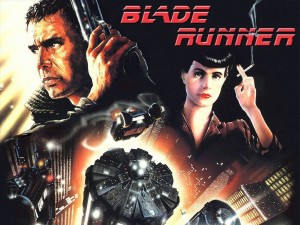 I started Speculative Fiction Friday to celebrate some of my favorite speculative fiction films, as well as others that I find interesting. I have talked about ones that I didn’t like, but I don’t include Blade Runner in that category.
I started Speculative Fiction Friday to celebrate some of my favorite speculative fiction films, as well as others that I find interesting. I have talked about ones that I didn’t like, but I don’t include Blade Runner in that category.
I consider Blade Runner to be a good film, but not essentially one of my favorites. It is a landmark of a film whose influence can be seen today, and was an incredible risk on the studio. It is an excellent demonstration of film noir, a type of film-making that was popular in the black-and-white era of films. Film noir plots usually consisted of a detective or other character trying to solve a mystery, and interacting with other shady characters along the way. The sets for a film noir were often mundane and minimalist, and framed in darkness. Blade Runner has sets that are futuristic, and they have a very, very freaky style and look to them that is quite unique.
Blade Runner is set in the year 2019, which, at the time of its release, was 37 years in the future. Los Angeles has become a massive city that stretches as far as the eye can see, with flying cars. For some reason, the sun never shines. This is the classic dark dystopia that has come to be a standard of most science-fiction movies, and it is hard to believe that we are only six years away from this. Yeah, don’t ever put a date on your film.
What is never seen in Blade Runner is the presence of “offworld colonies”. Apparently, a lot of humanity, perhaps the upper class, has decided to abandon a polluted earth for a wondrous future in space. Just imagine WALL-E, but with some people left behind. A corporation called Tyrell has made artificial human beings known as replicants, which are “more human than human”. These replicants look human, inside and out, and it is nearly impossible to tell the real from the artificial. This is really what Blade Runner is about, from a thematic standpoint, at least.
Actually, the plot is about Deckard, played by a still young Han Solo Harrison Ford. Ford plays Deckard, who is a Blade Runner, the one they call when a replicant goes rouge in order to “retire” (kill) them. The film is about a group of four, or maybe six replicants who are at large on planet Earth, and Deckard has to hunt them down. I know I was a little vague on the number of fugitive replicants, but I found there are a lot of things in this film that don’t add up, and I think it is deliberate.
Blade Runner was one of those films that could have been a lot of special effects and action scenes, but is not. I honestly think this film would be remembered at all if that was the case. As it was, this film spends a lot of time not saying its theme, which is how to prove that we are, in fact, human. Deckard uses a psychological questionnaire to determine whether someone is human or replicant, but he soon meets characters that do not know whether or not they are human. This is really what makes this film a psychological thriller that has made it a classic, that it plays with the viewer and main character’s sense of reality in such a way that I still, to this day, don’t understand.
However, I have seen a lot of films that I cannot explain, but like very much. I talked about Inception before, and I have to put Blade Runner on this list of films that I like but have no sense of closure. Just to let you know, I think there are three versions of this film, and I can’t say which is the best, honestly. I would just say see all of them.
Leave a Reply